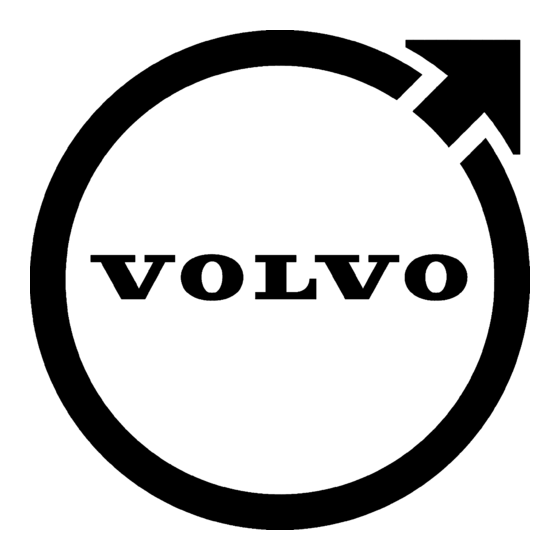Table of Contents
Advertisement
Quick Links
1995-96 ACCESSORIES & EQUIPMENT
Volvo Cruise Control Systems
850
NOTE:
1996 850 models are equipped with OBD II diagnostic
connector located in center console. Follow instructions
included with Volvo Scan Tool (998-8686-3) for diagnosis and
testing.
DESCRIPTION & OPERATION
MAIN SWITCH
Cruise control main switch is located at end of turn signal
lever. See Fig. 1. Selector switch has 3 positions, OFF, ON and
RESUME. SET button is at tip of lever.
BRAKE & CLUTCH VALVES
Brake and clutch valves are located on the pedal assembly.
See Fig. 2. Valve adjusts using small plastic catches which hook onto
plunger, holding it in place.
When pedal is up (valve actuated), spring is compressed,
switch is on and vacuum valve is closed. When pedal is down (valve
deactivated), spring pushes plunger back. Electric contact is broken
and vacuum valve opens to allow atmospheric pressure into the system.
Fig. 1:
Identifying Cruise Control Main Switch & Connector
Courtesy of Volvo Cars of North America.
CRUISE CONTROL SYSTEM
1995 Volvo 850
Advertisement
Table of Contents

Summary of Contents for Volvo 850
- Page 1 1995 Volvo 850 1995-96 ACCESSORIES & EQUIPMENT Volvo Cruise Control Systems NOTE: 1996 850 models are equipped with OBD II diagnostic connector located in center console. Follow instructions included with Volvo Scan Tool (998-8686-3) for diagnosis and testing. DESCRIPTION & OPERATION...
-
Page 2: Control Unit
Fig. 2: Locating Brake & Clutch Valves & Servo Courtesy of Volvo Cars of North America. CONTROL UNIT Control unit is located in underhood fuse and relay center. See Fig. 3. Control unit receives signals from sensor and switches. Main function of control unit is to decide if system can be controlled based on values and status of input signals, and to regulate system for optimal function. - Page 3 Fig. 3: Locating Control Unit & Terminal Identification Courtesy of Volvo Cars of North America. VACUUM PUMP & REGULATOR...
-
Page 4: System Tests
Vacuum pump and regulator are contained in one unit, located in left front corner of engine compartment. When cruise control system is operating, a 12-volt electric motor pumps vacuum when accelerator is depressed, sucking air out of tube which leads to vacuum servo. Air is pumped out through right coupling. - Page 5 Fig. 4: Locating Diagnostic Unit Courtesy of Volvo Cars of North America. CONNECTING DIAGNOSTIC SYSTEM Remove covers on diagnostic units. Connect selector cable to socket No. 2 on diagnostic unit "B". See Fig. 4. TRANSFER RATE TEST MODE 1) In this test mode, transfer rate (speed of information)
- Page 6 between control unit and diagnostic hookup can be changed. This is useful if system is read with a display instrument (scan tool). See TRANSFER RATE TEST CODES table. This step is not necessary if normal rate is desired, as this rate is loaded with each ignition start. 2) To enter transfer rate test mode, press activation button 4 times, holding button down about one second each time.
- Page 7 2-2-3 ......Shift A/T From "N" To "D" With Selector In OFF Position 1-3-2 ....... Depress Brake Pedal 3-1-1 ........Several Signals ¡ ¡ ¡ ¡ ¡ ¡ ¡ ¡ ¡ ¡ ¡ ¡ ¡ ¡ ¡ ¡ ¡ ¡ ¡ ¡ ¡ ¡ ¡ ¡ ¡ ¡ ¡ ¡ ¡ ¡ ¡ ¡ ¡ ¡ ¡ ¡ ¡ ¡ ¡ ¡ ¡ ¡ ¡ ¡ ¡ ¡ ¡ ¡ ¡ ¡ ¡ ¡ ¡ ¡ ¡ ¡ ¡ ¡ ¡ Selector Switch Test (Response Code 1-1-3) 1) Response Code 1-1-3 is obtained when selector is switched from OFF to ON, ON to OFF, or if brake or clutch pedal is depressed...
- Page 8 battery voltage is present, go to next step. If battery voltage is not present, replace selector switch. 2) Remove cruise control unit from under-hood fuse and relay center. See Fig. 3. Connect voltmeter between ground and cruise control unit base terminal 8T. Turn ignition on. Set cruise control selector switch to ON position.
-
Page 9: Vacuum System Check
3S. See Fig. 5. Turn ignition on. Fig. 5: Connecting Jumper Wires To Control Unit Base Terminals Courtesy of Volvo Cars of North America. 2) Connect other end of wire connected to terminal 3S to terminal 9S. Vacuum regulator should click. Connect other wire end to terminal 7S. - Page 10 3) Let vacuum servo remain contracted for at least 30 seconds to ensure there is no leakage in vacuum system. See Fig. 2. To release vacuum servo, remove wire from terminal 9S. Turn ignition off. If system operates as described, go to step 7). If system does not operate as described, go to next step.
- Page 11 or an abnormal speed signal. Code is stored only if control unit has had a normal signal at some time during road test and not for stationary interruptions. Code 1-2-2 is stored when ignition is turned on. It remains until vehicle speed is greater than 22 MPH for at least 15 seconds.
-
Page 12: Cruise Control Switch
1-1-1 (one press each time LED lights). Hold activation button down about one second each time. Read response code. Code 1-1-4 (Safety Disengagement) Code 1-1-4 is set in event of a safety disengagement. Safety disengagement does not necessarily mean something is wrong with system. -
Page 13: Brake Light Switch
BRAKELIGHT SWITCH Removal & Installation Remove brakelight fuse. Remove brakelight switch connector. Remove brakelight switch. To install, reverse removal procedure. WIRING DIAGRAM Fig. 6: Cruise Control System Wiring Diagram (1995-96)








